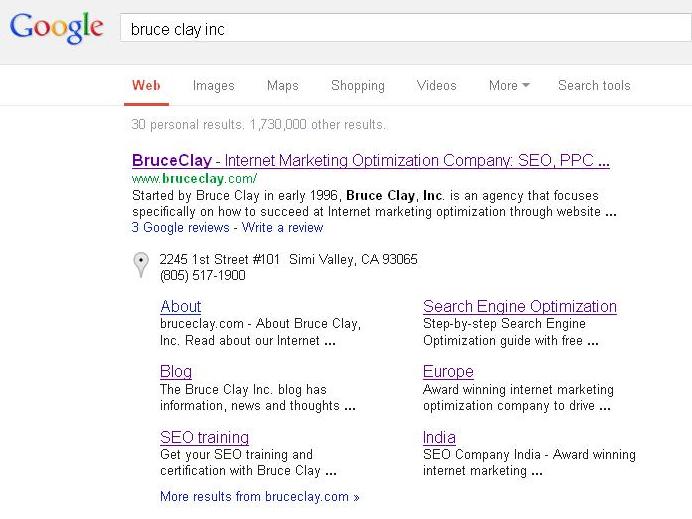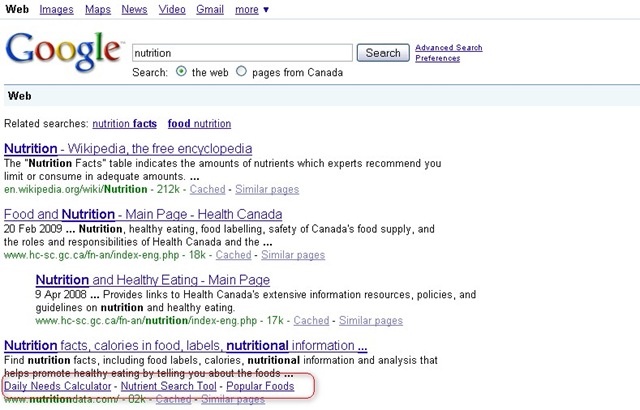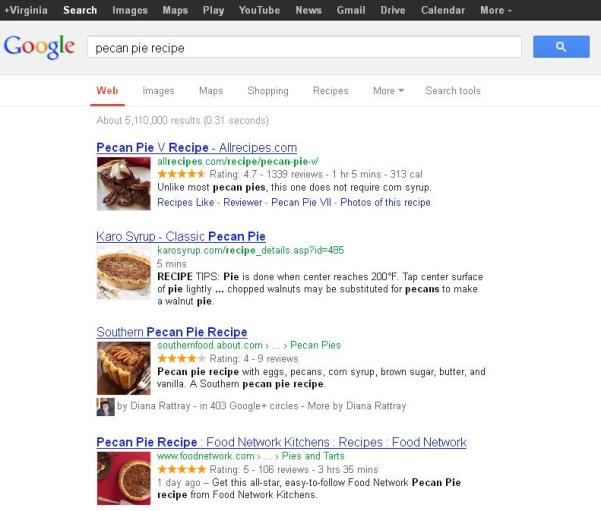Souping Up Your SERP: Snippet Tips for Small Biz SEO was originally published on BruceClay.com, home of expert search engine optimization tips.
You typed your business’s name into Google and you’re wondering how to enhance the way your result looks. How can you get those features you see when you type your competitor’s names in the search engine?
Here’s a resource guide on the ways you can dress up your results when they show up in Google. You’ve got a lot of things going on in your day-to-day running a business duties, so bookmark this page and come back to it whenever you have some time to dedicate to marketing.
Sitelinks
Sitelinks are multiple pages on a single domain linked to from one search result. Sitelinks have morphed over the years in their exact appearance. These days you’re likely to come across something like this in the SERP:

In a 2-column Sitelinks layout, up to 12 popular pages within a domain may be linked to. The links are often accompanied by a snippet of text describing the page and the URL.
You’ll also see one-line sitelinks popping up:
The current form of sitelinks and preference controls available to webmasters were established in 2011.
Optimizing Sitelinks
First, you should know that Google uses an algorithm to decide whether to display Sitelinks, and if so, which pages to use.
In a Google Webmaster Help video, Matt Cutts explains that Sitelinks don’t show up for every query, but are triggered mostly for navigational searches, when a website is likely to be in position one. He says, “We do it when we believe it’s useful for users and we have data to support that fact.”
So you can’t tell Google what pages to use as Sitelinks, but you can use Webmaster Tools to “demote” pages you’d prefer not show up as Sitelinks. You can think of Google’s ranking algorithm as a formula of positive and negative factors, and demoting is a negative signal and the only explicit one a site owner has to influence Sitelinks.
And you can influence Sitelinks on your site through SEO. As Google illuminates in its blog post, sitelinks are “generated and ranked algorithmically based on the link structure of your site.” This gives us insight into the importance of site structure, navigation and links in how Google designates pages for Sitelinks.
Read these 7 critical tactics for optimizing a site for Sitelinks.
Rich Snippets
A dressed up result is a big advantage in competing against the many links on Google’s results page. Rich snippets is Google’s name for these dressed up results, and webmasters can use special code markup to help Google generate them.
Here’s Google’s help resource for rich snippets. As you’ll see, there are a number of content types for rich snippets, including reviews, products, businesses and organizations, events and people.
Think of star ratings sitting in your business’s SERP snippet and the confidence it would instill in a searcher to click on your page. Or having product info, including product description, price and special offers listed right on the search result — a pretty compelling display. This is what you can do by adding some structured markup to your site pages. If you don’t believe me, some testing showed increased page views due to higher click-throughs from search results after rich snippets were implemented.
Optimizing Rich Snippets
The SEO’s Guide to Schema.org lists all the resources you need. Start by noting the announcements from Bing, Yahoo and Google about their joint support for Schema markup. When the major search engines come together for a cause, you know it’s a legitimate tool for search marketing and one that simply can’t be overlooked.
In there you also have access to Google’s announcement of its Structured Data Dashboard in Webmaster Tools. This is your toolbox for viewing and modifying structured data at the site level and page level as well as by item type.
And finally, you’ll want to view Google’s video tutorials about each of the different content types you can use structured markup on for rich snippets. The Schema Creator tool is helpful as it will do the job of writing the code for you. If you want to try your hand at it, know that the markup language used for rich snippets is relatively reasonable as far as difficulty to implement.
Authorship
One way to dress up a Google SERP listing is your smiling face. Not only will getting set up with Google Authorship give you a more attention-grabbing result, but you’ll also have access to more search analytics data in Webmaster Tools. Win win.
You can get your face in the SERP next to pages you wrote with 2 things:
1. A Google+ profile
2. Sign up for Google’s verified author program
An author photo on a snippet provides an undisputed advantage, increasing click-throughs for one SEO by 38 percent. One blog reported a difference of 484 percent click-throughs between authors with and without author photos. Understand that the advantage will quickly become a requirement in a level playing field as more people verify their Google+ profile and site authorship.
There are other benefits to verified authorship in Google. Google has reason to reward Google+ users, and theories that favorable SERP placement could be given to results with verified authors can’t be dismissed. Verified authors also get bonus links after a back-button click. If a search user clicks back to a Google SERP after having clicked through to a verified author’s post, more articles by that author will appear under the result.
Optimizing Authorship
Your Definitive Guide to Google Authorship Markup comes to you care of Search Engine Land. It explains in detail the various ways Google lets you verify your digital identity (there are three and it can get a little hairy so keep this step-by-step close).
No surprise, the quality of the author’s picture matters. One blogger tested photo variables including backgrounds and crop tightness, and in the end, his click through rate was 35 percent higher and engagement metrics showed improvement, too. Your audience and content will affect the image you may choose to use, yet however you represent yourself in your photo should be done with intention and quality in mind.
Author Stats in Webmaster Tools gives you valuable insight into how often your content is getting served up in a Google SERP. You’ll see the number of impressions and clicks, the click through rate and the average position of your content.
Some extra notes that probably don’t apply to everyone but should be mentioned:
- Google allows for verification of authorship with an email address instead of a Google+ profile, but it’s not as clean and reliable a solution and so it’s not the preferred method.
- For writers who contribute to more than one site, use the “Contributor to” include all the publications you write for.
- WordPress can throw up some additional obstacles to implementing rel=”author” which you can read about in the SEL guide.
And of course, you’ll want this tool handy through all your optimization planning and implementation: Google’s Rich Snippet Testing Tool. You can preview what your SERP snippet will look like using the URL or plugging in the HTML. Happy optimizing!
Source : internetwebsitedesign[dot]biz









0 comments:
Post a Comment